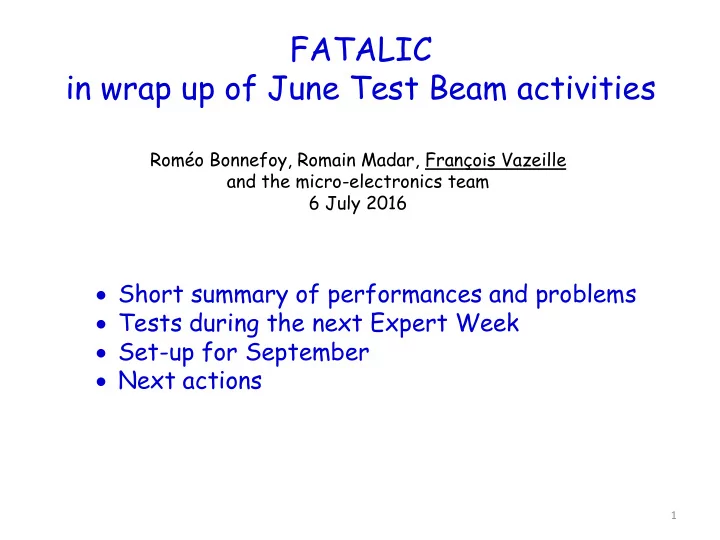

FATALIC in wrap up of June Test Beam activities Roméo Bonnefoy, Romain Madar, François Vazeille and the micro-electronics team 6 July 2016 Short summary of performances and problems Tests during the next Expert Week Set-up for September Next actions 1
Short summary of performances and problems Set-up ▪ Assembly of complete Drawers 3 (10 PMTs) and 4 (11 PMTs) for a LB module, with Standard Main Boards, Daughter Boards and Remote HV system. ▪ Insertion of Drawer 3 only (Drawer 4 for QIE). ▪ Connection to the PPR. Reference tests at LPC on individual PMT Blocks connected one by one to the same channel of the MB Prototype (HV off) Pedestals + electronic noise. counts High Frequency High Gain noise 3,4 Mean noise over 21 PMTs: 3,2 2.80 0.05 counts 3 or 6.74 0.05 fC 2,8 with: 2,6 minimum: 5.77 0.16 fC 2,4 maximum: 7.64 0.29 fC 2,2 2 25 26 27 28 29 30 31 32 33 34 35 36 37 38 39 40 41 42 43 44 45 46 47 48 PMT location 2
Measurements at CERN using the Standard MB + DB + PPR + FLVPS and Remote HV on the Drawer 3 inside LB Good working of the whole MB-DB-PPR communication, despite the PPR spectra invert the time! PMTS at their nominal gains. Pathological aspects of some of the Pedestal spectra and/or increased width as far as the MB channel input is far from its FPGA! (See Back up slides) ▪ Explanation: bad transmission of some bits from FATALIC to the FPGA’s on the Main Board, because of the capacitance effect of tracks. ▪ How to cure it? To boost the digital information with a buffer on the All-in-One card (to validate) PMT30, close PMT26, far then inside FATALIC New FATALIC5 specif. PMT correlation on the same cell - Rough calculation. - Hadrons at 90°. Other data taken after the official Test Beam period … not yet analyzed. 3
Tests during the next Expert Week First Cesium tests using the digital summation over 10 ms of HF data. Requests the access to the Drawer 3 in order to modify the FPGA firmware, and to the PPR data stream (in principle close to the Chicago one). (Wednesday 20 to Friday 22) September Test Beam The same set-up as this one of June, but with the Drawers 3 and 4 on LB Module. The recorded data will be more significant on the channels close to their FPGA. Study of the Optimal Filtering. Next actions Validation of the buffer concept by using a modified All-in-One card. New simulations of FATALIC with an additional buffer inside ( FATALIC5). New studies of a complementary analog integrator for very low currents (Ilya’s request): will be reported at the October TileCal week. It is urgent to coordinate the radiation studies to quantify the requested funds. The dates of the 2017 Test Beam periods will condition the FATALIC5 availability. 4
BACK UP 5
High Gain Pedestals, RMS and positions (Straight line distances*) 9.0 5.5 4.2 5.9 3.5 36(280mm) 34(175mm) 32(60 mm) 30(55 mm) 28(60 mm) 26(175 mm) X X X X X 4 2 3 1 X X X X X 35(175 mm) 33(60 mm) 31(55 mm) 29(60 mm) 27(175 mm) 25(280 mm) Example: Example: pathological large 4.4 6.9 3.3 7.1 5.3 *Warning: Distances not taking into account the bending path in MB and the PMT Block connections. 6
Pedestal CERN/Pedestal LPC PMT position (Straight line distance ) Noise CERN/Noise LPC 26/31 624/644 285/291 406/401 179/179 5.9/2.7 5.5/2.8 4.2/3.1 3.5/2.6 9.0/2.6 36(280mm) 34(175mm) 32(60 mm) 30(55 mm) 28(60 mm) 26(175 mm) X X X X X 4 2 3 1 X X X X X 35(175 mm) 33(60 mm) 31(55 mm) 29(60 mm) 27(175 mm) 25(280 mm) 384/391 593/577 358/356 390/397 416/435 7.1/2.8 3.3/2.6 4.4/3.2 5.3/2.4 6.9/3.2 7
Medium Gain Pedestals, RMS and positions (Straight line distances*) 2.1 1.6 1.6 1.5 2.0 36(280mm) 34(175mm) 32(60 mm) 30(55 mm) 28(60 mm) 26(175 mm) X X X X X 4 2 3 1 X X X X X 35(175 mm) 33(60 mm) 31(55 mm) 29(60 mm) 27(175 mm) 25(280 mm) 2.0 1.8 1.9 1.7 1.5 *Warning: Distances not taking into account the bending path in MB and the PMT Block connections. 8
Pedestal CERN/Pedestal LPC PMT position (Straight line distance ) Noise CERN/Noise LPC 85/82 275/277 235/233 291/286 180/183 2.0/1.6 1.6/1.2 1.6/1.4 1.5/1.3 2.1/1.4 36(280mm) 34(175mm) 32(60 mm) 30(55 mm) 28(60 mm) 26(175 mm) X X X X X 4 2 3 1 X X X X X 35(175 mm) 33(60 mm) 31(55 mm) 29(60 mm) 27(175 mm) 25(280 mm) 237/229 188/171 256/246 286/287 209/211 1.9/1.3 1.7/1.5 2.0/1.3 1.5/1.4 1.8/1.4 9
RMS in ADC counts for High Gain 10 9 8 7 FPGA1 6 FPGA2 5 FPGA3 4 FPGA4 3 2 1 0 0 50 100 150 200 250 300 Straight distance in mm (rough approximation) Conclusion: - Pedestal peaks comparable to the individual results of PMT Blocks alone. - Pedestal shapes and/or RMS values are better for channels close to their FPGA, and slightly above the individual RMS results: Examples for HG: # 28: 3.5 (8.4 fC) instead of 2.6 counts (PMT Block alone) # 31: 3.3 ( 7.9 fC) instead of 2.6 counts # 30: 4.2(10.1 fC) instead of 3.1 counts # 29: 4.4 (10.6 fC) instead of 3.2 counts Comment: The set-up is more complete with respect to PMT Block alone. - Pedestal shapes and/or RMS values worst for channels far from their FPGA. Warning: this RMS should be better if we considered only High Frequency noise. 10
Recommend
More recommend